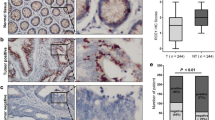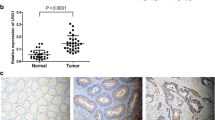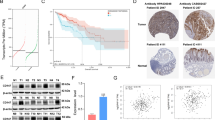Abstract
Purpose
We aim to evaluate the diagnostic value of ribonuclease inhibitor (RI) in colorectal cancer (CRC) and investigate the important role of RI in cell growth and metastasis of CRC.
Methods/patients
In this study, the expression of RI was evaluated in human CRC samples with different histological grade and the association between RI expression and clinicopathological parameters was investigated. Furthermore, the exogenous RI gene was introduced into human HT29 CRC cells and the effects of RI on cell proliferation and metastasis were determined in vitro. The PI3K/Akt signaling pathway and some related protein molecules were detected.
Results
RI is downregulated in CRC tissues compared to adjacent normal tissues and its expression is inversely associated with histological grade, pathological stage, and venous invasion, respectively. Multivariate analysis showed that RI expression was an independent prognostic factor for overall survival. In addition, the exogenous overexpression of RI reduced the proliferation and migration of HT29 CRC cell line in vitro by inhibiting the PI3K/Akt signaling pathway and suppressing the expression of vascular endothelial growth factor (VEGF) and upregulating phosphatase and tensin homolog (PTEN).
Conclusions
RI represents an important predictor of progression in patients with CRC and suppresses proliferation and metastasis in CRC cells through inhibiting PI3K/AkT pathway.




Similar content being viewed by others
Explore related subjects
Discover the latest articles and news from researchers in related subjects, suggested using machine learning.References
Siegel R, Naishadham D, Jemal A. Cancer statistics, 2013. CA Cancer J Clin. 2013;63(1):11–30. doi:10.3322/caac.21166.
Jemal A, Bray F, Center MM, Ferlay J, Ward E, Forman D. Global cancer statistics. CA Cancer J Clin. 2011;61(2):69–90. doi:10.3322/caac.20107.
Kobe B, Deisenhofer J. A structural basis of the interactions between leucine-rich repeats and protein ligands. Nature. 1995;374(6518):183–6. doi:10.1038/374183a0.
Kobe B, Deisenhofer J. Crystal structure of porcine ribonuclease inhibitor, a protein with leucine-rich repeats. Nature. 1993;366(6457):751–6. doi:10.1038/366751a0.
Shapiro R. Cytoplasmic ribonuclease inhibitor. Methods Enzymol. 2001;341:611–28 (pii: S0076-6879(01)41180-3).
Futami J, Tsushima Y, Murato Y, Tada H, Sasaki J, Seno M, et al. Tissue-specific expression of pancreatic-type RNases and RNase inhibitor in humans. DNA Cell Biol. 1997;16(4):413–9.
Nadano D, Yasuda T, Takeshita H, Uchide K, Kishi K. Purification and characterization of human brain ribonuclease inhibitor. Arch Biochem Biophys. 1994;312(2):421–8. doi:10.1006/abbi.1994.1328.
Yao X, Li D, Xiong DM, Li L, Jiang R, Chen JX. A novel role of ribonuclease inhibitor in regulation of epithelial-to-mesenchymal transition and ILK signaling pathway in bladder cancer cells. Cell Tissue Res. 2013;353(3):409–23. doi:10.1007/s00441-013-1638-2.
Pan X, Xiong D, Yao X, Xin Y, Zhang L, Chen J. Up-regulating ribonuclease inhibitor inhibited epithelial-to-mesenchymal transition and metastasis in murine melanoma cells. Int J Biochem Cell Biol. 2012;44(6):998–1008. doi:10.1016/j.biocel.2012.03.008.
Chen JX, Gao Y, Liu JW, Tian YX, Zhao J, Cui XY. Antitumor effects of human ribonuclease inhibitor gene transfected on B16 melanoma cells. Int J Biochem Cell Biol. 2005;37(6):1219–31. doi:10.1016/j.biocel.2004.11.020.
Tian YX, Wang DM, Cui XY. Analysis of gene expression of ribonuclease inhibitor in human breast cancer tissue. Ai Zheng. 2004;23(3):269–72 (pii: 10000467X2004030269).
Fan J, Wang S, Yu S, He J, Zheng W, Zhang J. N-acetylglucosaminyltransferase IVa regulates metastatic potential of mouse hepatocarcinoma cells through glycosylation of CD147. Glycoconj J. 2012;29(5–6):323–34. doi:10.1007/s10719-012-9414-1.
Chen JS, Wang Q, Fu XH, Huang XH, Chen XL, Cao LQ, et al. Involvement of PI3 K/PTEN/AkT/mTOR pathway in invasion and metastasis in hepatocellular carcinoma: association with MMP-9. Hepatol Res. 2009;39(2):177–86. doi:10.1111/j.1872-034X.2008.00449.x.
Lee FS, Vallee BL. Structure and action of mammalian ribonuclease (angiogenin) inhibitor. Prog Nucleic Acid Res Mol Biol. 1993;44:1–30.
Kobe B, Kajava AV. The leucine-rich repeat as a protein recognition motif. Curr Opin Struct Biol. 2001;11(6):725–32 (pii: S0959-440X(01)00266-4).
Xu ZP, Tsuji T, Riordan JF, Hu GF. The nuclear function of angiogenin in endothelial cells is related to rRNA production. Biochem Biophys Res Commun. 2002;294(2):287–92. doi:10.1016/S0006-291X(02)00479-5S0006-291X(02)00479-5.
Moroianu J, Riordan JF. Nuclear translocation of angiogenin in proliferating endothelial cells is essential to its angiogenic activity. Proc Natl Acad Sci U S A. 1994;91(5):1677–81.
Dickson KA, Haigis MC, Raines RT. Ribonuclease inhibitor: structure and function. Prog Nucleic Acid Res Mol Biol. 2005;80:349–74. doi:10.1016/S0079-6603(05)80009-1.
Dickson KA, Kang DK, Kwon YS, Kim JC, Leland PA, Kim BM, et al. Ribonuclease inhibitor regulates neovascularization by human angiogenin. Biochemistry. 2009;48(18):3804–6. doi:10.1021/bi9005094.
Fu P, Chen J, Tian Y, Watkins T, Cui X, Zhao B. Anti-tumor effect of hematopoietic cells carrying the gene of ribonuclease inhibitor. Cancer Gene Ther. 2005;12(3):268–75. doi:10.1038/sj.cgt.7700742.
Zhou JH, Tang XY, Zhao R, Wang H, Xia J. Effects of ribonuclease inhibitor on apoptosis and invasion of human breast cancer MDA-MB-231 cells. Xi Bao Yu Fen Zi Mian Yi Xue Za Zhi. 2012;28(3):260–4.
Pizzo E, Sarcinelli C, Sheng J, Fusco S, Formiggini F, Netti P, et al. Ribonuclease/angiogenin inhibitor 1 regulates stress-induced subcellular localization of angiogenin to control growth and survival. J Cell Sci. 2013;126(Pt 18):4308–19. doi:10.1242/jcs.134551.
Chen J, Ou-Yang X, Gao J, Zhu J, He X, Rong J. Knockdown of ribonuclease inhibitor expression with siRNA in non-invasive bladder cancer cell line BIU-87 promotes growth and metastasis potentials. Mol Cell Biochem. 2011;349(1–2):83–95. doi:10.1007/s11010-010-0663-7.
Wey JS, Fan F, Gray MJ, Bauer TW, McCarty MF, Somcio R, et al. Vascular endothelial growth factor receptor-1 promotes migration and invasion in pancreatic carcinoma cell lines. Cancer. 2005;104(2):427–38. doi:10.1002/cncr.21145.
Xiao N, Qi XY, Tang LN, Tan LL, Chen YQ, Zhao HM. VEGF promotes cardiac stem cells differentiation into vascular endothelial cells via the PI3 K/Akt signaling pathway. Artif Cells Nanomed Biotechnol. 2013. doi:10.3109/21691401.2013.837473.
Xu J, Jia L, Ma H, Li Y, Ma Z, Zhao Y. Axl gene knockdown inhibits the metastasis properties of hepatocellular carcinoma via PI3 K/Akt-PAK1 signal pathway. Tumour Biol. 2013;35(4):3809–17. doi:10.1007/s13277-013-1521-5.
Sussman M. “AKT”ing lessons for stem cells: regulation of cardiac myocyte and progenitor cell proliferation. Trends Cardiovasc Med. 2007;17(7):235–40. doi:10.1016/j.tcm.2007.08.003.
Chetty C, Lakka SS, Bhoopathi P, Rao JS. MMP-2 alters VEGF expression via alphaVbeta3 integrin-mediated PI3 K/AKT signaling in A549 lung cancer cells. Int J Cancer. 2010;127(5):1081–95. doi:10.1002/ijc.25134.
Achiwa Y, Hasegawa K, Udagawa Y. Regulation of the phosphatidylinositol 3-kinase-Akt and the mitogen-activated protein kinase pathways by ursolic acid in human endometrial cancer cells. Biosci Biotechnol Biochem. 2007;71(1):31–7 (pii: JSTJSTAGE/bbb/60288).
Molinari F, Frattini M. Functions and regulation of the PTEN gene in colorectal cancer. Front Oncol. 2014;3:326. doi:10.3389/fonc.2013.00326.
Acknowledgments
This work was supported by Grant from the National Science Foundation of China (No. 81302310 and No. 31400687).
Conflict of interest
The authors have declared that no conflict of interest exists.
Author information
Authors and Affiliations
Corresponding author
Rights and permissions
About this article
Cite this article
Tang, Y., Liu, P., Tian, Y. et al. Overexpression of ribonuclease inhibitor defines good prognosis and suppresses proliferation and metastasis in human colorectal cancer cells via PI3K/AKT pathway. Clin Transl Oncol 17, 306–313 (2015). https://doi.org/10.1007/s12094-014-1228-0
Received:
Accepted:
Published:
Issue Date:
DOI: https://doi.org/10.1007/s12094-014-1228-0




